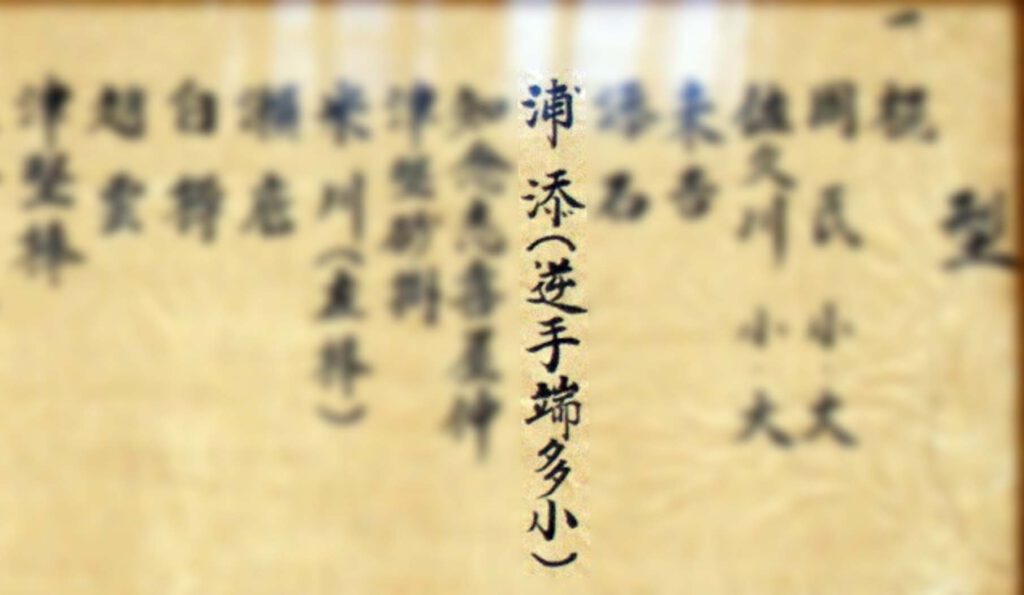Urasoe no Kon is a kata name that first appeared in the postwar era. That is, none of the kata lists presented by Miki (1930) and Taira (1938) included the name Urasoe no Kon, nor does it appear elsewhere. While students in some dōjō learn one combination from it as early as in the basic techniques taught from the start, today, Urasoe no Kon is a high grading kata of about 7th dan level. Although it might be performed in other schools, it is a kata of Taira lineage kobudō, and Taira first mentioned it in 1964.
Where did the name Urasoe no Kon came from, and when?
Well, those who study the culture of Okinawan kobudō probably stumbled over the names Tsuken Kōra-gwā and Tsuken Hanta-gwā. It is often related to the frustrating experience that nothing definite can be found, and even the highest sensei have not an answer.
About this matter, I want to say the follwong. In 1948, Yun wrote as follows:
Old man Kōra-gwā (between 100 and 300 years ago)
Only the name of this sensei was known and handed down, and I could not find a detailed description, so I decided to just list him as a great master of bōjutsu.
As mentioned earlier, Taira Shinken later copied Yun’s research and presented it in partially altered in 1964, where Yun’s entry became this:
Tsuken Kōra-gwa Sensei
There is no detailed description of this sensei, except that he is listed as a great master of bōjutsu, but he is said to have devised the Urasoe no Kon and the Kōra-gwā school of saijutsu.
In short, Yun described Kōra-gwā as a great master of bōjutsu, but admits that besides his name nothing more is known about him, or his technique. Taira on the other hand adds that he devised Urasoe no Kon and the Kōra-gwā school of saijutsu.
Well, Yun in 1948 also wrote about a certain Tsuken Sensei, who is a different person:
Tsuken Sensei (120 to 130 years ago)
Speaking of Tsuken Sensei, Hanta-gwā no Kon immediately comes to mind. [Tsuken] Sensei has studied variously, but what makes him different from other sensei is the overhand grip of the bō (gyaku-te no bō). Tsuken Hanta-gwā no Kon is the fruit of his representative research, with its characteristic overhand grip of the bō.
This was copied by Taira without any significant change or additions.
Tsuken Sensei (100 years ago)
As the Sensei who invented the Tsuken Hanta-gwā no Kon, he has conducted various research, and Tsuken Hanta-gwā no Kon is the fruit of his representative research, and it’s characteristic is the overhand grip of the bō (gyaku-te no bō).
In later times obviously further consolidation of data has taken place. On a kata list written by Akamine Eisuke of Shimbukan – a student of Taira Shinken – are written the kata names of the association. Among it is “Urasoe (Gyaku-te Hanta-gwā).” Moreover, the list also shows a saijutsu kata named Hanta-gwā.
In other words, here, Tsuken Hanta-gwā no Kon has by then been equated with Urasoe no Kon. Obviously, this happened due to some changes made to the original source and over time. Let me say this: without the original source (Yun 1948), it is impossible to unravel the confusion about Hanta-gwā, Kōra-gwā, and Urasoe.
Again, while Yun wrote in 1948 that nothing is known about Tsuken Kōra-gwā except his name and that he was a great master of bōjutsu, and that a different person named Tsuken Sensei devised Tsuken Hanta-gwā no Kon, Taira in 1964 wrote that Tsuken Kōra-gwā devised Urasoe no Kon as well as the Kōra-gwā school of saijutsu. Later, Taira’s student Akamine Eisuke equated Urasoe no Kon with Tsuken Hanta-gwā no Kon, and furthermore added a Hanta-gwā no Sai to his list.
And in this way, Tsuken Hanta-gwā no Kon became Urasoe no Kon.
© 2022 – 2023, Andreas Quast. All rights reserved.


